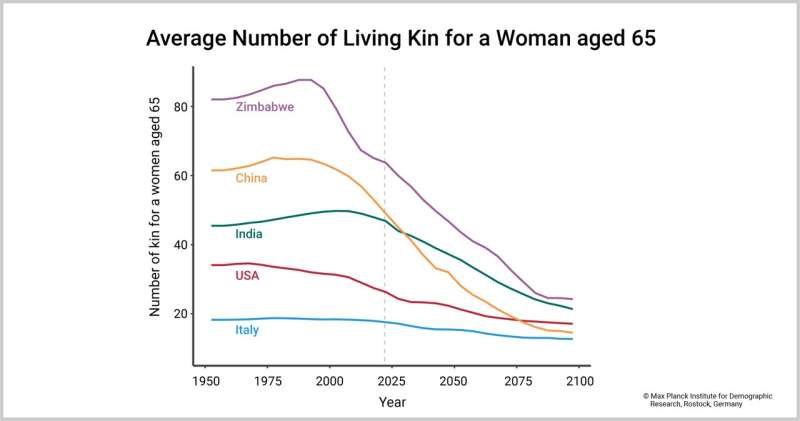This article has been reviewed according to Science X's editorial process and policies. Editors have highlighted the following attributes while ensuring the content's credibility:
fact-checked
peer-reviewed publication
trusted source
proofread
Families will change dramatically over the years to come, says study

The number of relatives that an individual has is expected to decrease by more than 35% in the near future. At the same time, the structure of families will change. The number of cousins, nieces, nephews and grandchildren will decline sharply, while the number of great-grandparents and grandparents will increase significantly. In 1950, a 65-year-old woman had an average of 41 living relatives. By 2095, a woman of the same age will have an average of only 25 living relatives.
Diego Alburez-Gutierrez is head of the Research Group Kinship Inequalities at the Max Planck Institute for Demographic Research (MPIDR) in Rostock. Together with Ivan Williams of the University of Buenos Aires and Hal Caswell of the University of Amsterdam, he recently published a study projecting the evolution of human kinship relationships worldwide.
The work is published in the Proceedings of the National Academy of Sciences.
"We asked ourselves how demographic change will affect the 'endowment' of kinship in the future," Alburez-Gutierrez explains. "What was the size, structure, and age distribution of families in the past, and how will they evolve in the future?"
For the study, the researchers analyzed historical and projected data from the 2022 revision of the United Nation's World Population Prospects.
"We use mathematical models to represent the relationship between a person, their ancestors, and their descendants in a given time period. The model provides average age and sex distributions for different types of kinship for each calendar year," says Alburez-Gutierrez. One thousand kinship histories were calculated for each country.
Shrinking families
The researchers documented differences in family size around the world, which they defined as the number of living great-grandparents, grandparents, parents, children, grandchildren and great-grandchildren, aunts and uncles, nieces and nephews, siblings and cousins.
"We expect the overall size of families to decline permanently in all regions of the world. We expect the largest declines in South America and the Caribbean," says Alburez-Gutierrez.
In 1950, the average 65-year-old woman there had 56 living relatives. By 2095, that number is expected to drop to 18.3 relatives, a 67% decline. In North America and Europe, where families are already comparatively small, the changes will be less pronounced. Here, a woman aged 65 had about 25 living relatives in 1950 but by 2095 she will have only 15.9 relatives.
Relatives play a crucial role in providing of informal care
Projections of kinship are critical in the context of rapidly aging populations, as smaller birth cohorts must increasingly care for older adults who have fewer or no relatives.
"Our findings confirm that the availability of kinship resources is declining worldwide. As the age gap between individuals and their relatives widens, people will have family networks that are not just smaller, but also older. Consider the case of grandparents and great-grandparents, who are expected to be in greater supply in the future. While this could theoretically help ease the burden of childcare for parents, these (great-)grandparents may actually need care themselves."
The study underscores the need to invest in social support systems that ensure the well-being of individuals at all stages of life. A large proportion of the world's population does not currently have access to highly developed social support systems. For them, family ties remain an important source of support and informal care, and this is likely to remain the case in the future.
"These seismic shifts in family structure will bring about important societal challenges that policymakers in the global North and South should consider," says Alburez-Gutierrez.
More information: Diego Alburez-Gutierrez et al, Projections of human kinship for all countries, Proceedings of the National Academy of Sciences (2023). DOI: 10.1073/pnas.2315722120
Journal information: Proceedings of the National Academy of Sciences
Provided by Max Planck Society




















